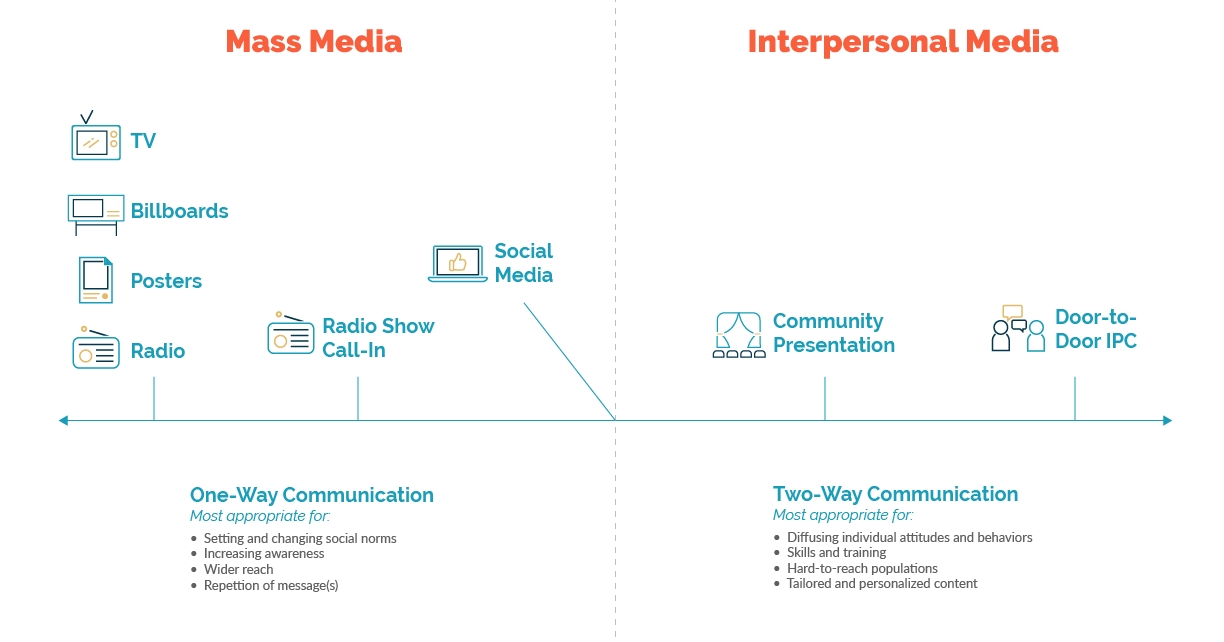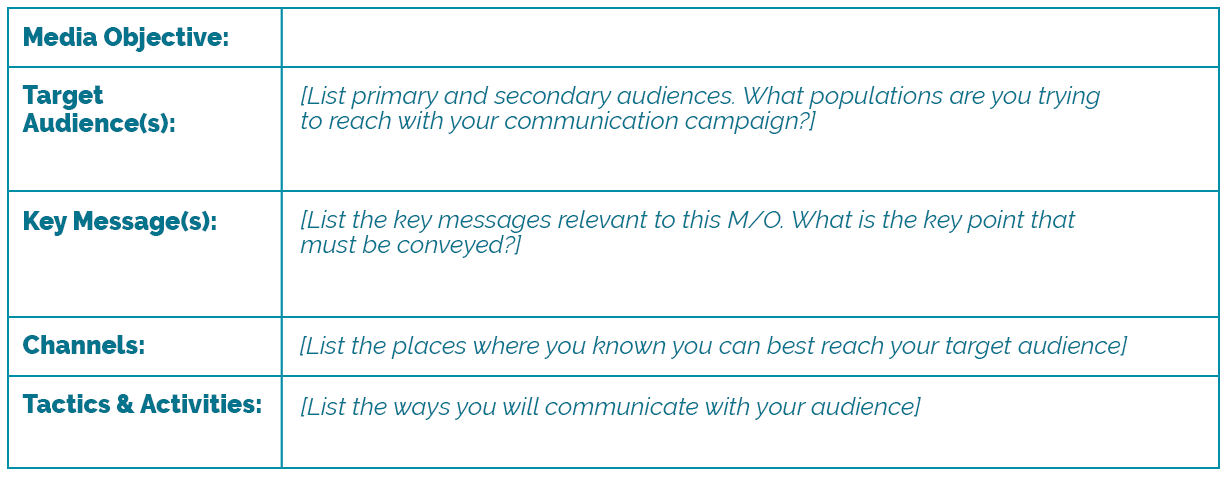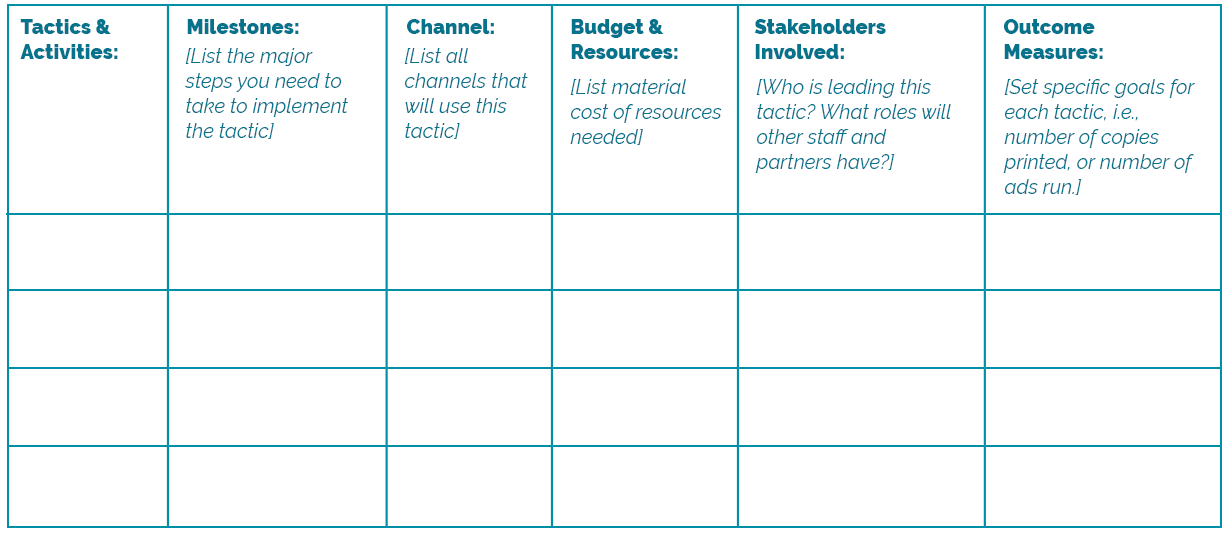Your media plan is how you will reach the right audience, at the right time, with the right message. Having (and following) a media plan is the best way to stay on-track during the implementation process; it will also form the basis of your later work evaluating your media reach and performance.
The choices you make in this phase will grow from your research and strategy development; many of the components you have already developed will go into your media plan, but in this phase, you will tailor them for the purposes of channel selection. There is no “correct” way to create and format a media plan, but the following to-dos will help ensure you cover all of your bases.
Case Study
A Brief Primer on Paid vs. Earned Media
Understanding the differences between “paid” and “earned” media is vital to spreading your message.
Paid Media:
Paid media is any marketing that you pay for. Traditionally, this includes TV spots, radio spots, and print advertising. Today, search engine advertising is another of the most common forms of pay-per-click marketing. Implementers can bid on specific “keywords;” when users in a particular geographic location search for those keywords, they will see advertised results displayed above the organic search results. Advertisers pay “per click,” or every time someone clicks on the advert to be directed to your website.
Another sphere of paid media, which is relatively new, is sponsored social media posts. One reason for this change is that many social networks have introduced algorithm changes that reduce the number of people an organization or campaign can reach organically; paying a channel to prominently display marketing content can boost the number of people exposed to your message.
Earned Media:
Earned media consists of all the content and conversation around the product that has been created by somebody else and published somewhere other your owned channels (eg: your website). Earned media can include press coverage, social media mentions, shares and retweets, product reviews, and blog posts authored externally. Increasing the visibility and reach of your content through social media engagement will increase your earned media.
In this section, we’ll go into detail about how to create a plan for paid media as well as how to generate, and plan for, earned media (journalist engagement, specifically).

To-Do List
- Create an audience profile
- Define your objectives
- Map out tactics and timeline
- Select media channels
1. Create an audience profile
By now, you have defined (and refined) your target audience, and you know the people you’re trying to engage very well. For the purposes of the media plan, you’ll return to this description, translating it into terms that will be useful for media and dissemination channels. Towards that end, you’ll primarily describe your audience in terms of demographics and psychographics.
- Demographics are the basic facts about the audience, such as gender, age, level of education, level of income, mobility, marital status, employment type(s) and status, type of residence, geographical location, health status, sexual orientation and similar features. For example, a target audience may be demographically defined as “women aged 18-35 with children aged 3 or younger.”
- Psychographics offer a more refined picture of the audience, with insight into their desires, emotions, and needs. A psychographic audience definition can include personality traits, beliefs and attitudes about social issues, personal interests, and level of knowledge about certain issues. For example, psychographic principles can define an audience as “young men with drive and a desire to serve their country.”
Create a demographic and psychographic audience profile for your media plan, starting with these questions (although you should also be thinking beyond this list):
- Who are the specific people in your target audience?
- Why did you select this specific target audience?
- What are your target audience’s values?
- What are their aspirations? How are they trying to achieve them?
- What are their biggest challenges in life? How are they trying to prevent/avoid them?
- What are their preferred media channels?
- How do they interact with others on- and offline?
- What are they interested in? What hobbies do they have?
- What does a “day in their life” look like? Where do they go, what are they doing, where do they spend their time?
2. Define your objectives
Just like your audience profiles, you’ve established and refined your campaign objectives with clarity by now; again, you must rephrase and refocus these objectives for your media plan, so that they are specifically tailored to the use of media. You’ll use these media objectives to select the most appropriate media channels for your campaign.
To map out your media objectives, start with your communication objectives. Think about how each can be achieved through media, for example:
- Objective: Correct misperceptions about the effectiveness of prophylactics among couples where one partner is HIV-positive.
- Media objective: Educate and increase knowledge on prophylactics by reaching 60 percent of target audience a minimum of three times in the first four weeks of the campaign.
Note that this media objective flows directly from the objective—that is, achieving the media objective will lead to progress on the objective. Note also that the media objective is measurable and actionable, and includes a goal and timeframe.

That said, this is not the time to establish HOW you will accomplish the objective—you’ll choose media channels and specific tactics in the next section. For now, focus on the WHAT.
You can use the Media Objectives Template to work through your media objectives.
3. Select media channels
With your media plan mostly in place, it’s time to choose the specific media channels you’ll use. In Phase 3, you broadly selected the media channels you planned to use as part of your strategy. Now, you’ll refine and make detailed choices. Selecting appropriate and culturally competent channels is one of the most important factors you can control in the success of your campaign—your research should guide your selection.
Consider the following questions:
- What channels do your target audiences currently access? (eg: newspapers, radio, posters, flyers, and social media)
- When, where, and how do your audiences access these channels?
- What differences exist between genders?
- What channels do your target audiences avoid? Do they perceive any with hostility?
- When considering health-related information, what sources do your audiences consider most credible?
- Where do they expect to receive information regarding health and disease prevention?
- Are there any unexpected channels that may actually be effective ways to communicate your message? (for example, adolescent girls and young women may be engaged through “make-up parties”)
- Who are their influencers? Who do they look up to, or respect and admire (locally, nationally or globally)? Who do they look to for advice with regards to sex or sexual health?
To turn the answers of these questions into actionable media selections, you need to understand how your objectives can be achieved within the existing information landscape. Broadly, most media today can be classified as either mass media or interpersonal media.
- Mass media include print, radio, television, Internet, social media, and out-of-home advertising (such as billboards and signs).
- To reach audiences through these channels, your tactics may include publishing op-eds or editorial pieces; publishing feature articles; broadcasting documentary film on television; broadcasting public service announcements; distributing pamphlets; or purchasing billboard advertisements.
- Interpersonal media can also include social media and internet sources, as well as face-to-face communications (such as healthcare worker or peer-to-peer interactions).
- To reach audiences through these channels, tactics may include presentations, informal discussions/counseling, courses, meetings, and workshops.
As you can likely see from the descriptions, many media channels fall into both categories in today’s changing media landscape; moreover, all media exist on a spectrum of interaction with audiences:

Look at the list of channels you select, consider where each fits on this diagram. As a whole, are you choosing media channels with the reach, targeting, level of interaction, and other factors that your strategy requires?
Note that you will likely want to create what’s known as a multi-level campaign, which uses a combination of one- and two-way media tactics while promoting consistent messages across all channels. These types of campaigns are traditionally more effective than single channel campaigns.
Sometimes you may need to weigh between different media channels to make the right decision about which would help you achieve your objectives best. For example, you may need to compare channels on two terms:
- Reach refers to the percentage of the target audience that sees your message within a given time. How much reach can an identified media channel give you?
- Impressions are the total number of exposures to a campaign. One person can receive multiple exposures over time.
You will also consider budget and cost, creative requirements, geographic allocations, and media schedule.
4. Map out tactics and timelines
It’s time to create the most substantial part of your implementation plan. The details you establish now will keep you organized throughout the campaign.

Working from your overall objectives, use the template below to build out your tactics and timeline. Check to make sure your tactics are not too broad. Connecting each tactic to a specific communications objective will help you identify how best to narrow each one down.

Now, working from the table above, organize your tactics into a plan. Create a different row for each tactic:

Finally, organize the Milestones of your tactics into a broad timeline (also known as a rollout plan). Note, this template uses months as an example, but you should use any timeframe appropriate to your campaign. Your time period may be months, weeks, or even days. Download the Tactics & Timeline template.

Checking in on your progress.
Choosing media channels may feel like the most crucial part of the entire process; after all, there are many variables to consider, and budget and time constraints add real pressure. However, this step should rest firmly on the work you’ve done so far, developing research and strategy that will guide these big decisions. Remember to refer back to your evidence, and make sure your media plan is grounded in your evidence.